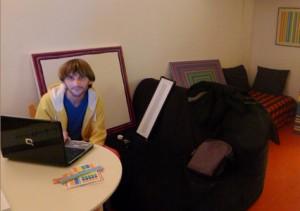Color-blind artist uses sounds to ‘see’ color
Neil Harbisson, who is colorblind, sits in his studio, in Mataro, Spain. A technological device allows him to hear the colors he cannot see. (Photo by Gerry Hadden.)
When you walk into the produce section of a supermarket, you see yellow bananas, red peppers, green spinach. For Neil Harbisson, though, it’s all shades of gray.
He’s color-blind.
Harbisson, who’s half-Irish and half-Spanish, is also an artist. And with the help of a high-tech headset, he can “hear” color. The headset is essentially a webcam that hangs over his forehead like a third eye — it’s called an eyeborg. It was built for him by British technology expert Adam Montandon.
The camera reads color frequencies, and then sends the frequencies to a tiny chip that translates them into sound. The sound is then pulsed directly into his skull, via a headband that keeps the whole thing snug on his head.
“I don’t see it as a device anymore, I see it as part of my body,” said Harbisson. “I started feeling this the same year I started using it, in 2004. I started to feel that the software and my brain were creating a new sense, and there was a point in which I couldn’t differentiate between what was given by the software and what came from my brain. I decided not to take it off anymore, and it’s been a part of my body since then.”
Harbisson, 28, lives in a tiny studio off his family home, Mataro, Spain. Even though he was born color-blind, he was fascinated by colors and decided to study them.
Harbisson got into art school, after teachers made an exception, letting him paint only in the gray scale. He went on to study color theory.
“I understood that color was very complex. It’s not a simple thing,” he said.
Color, he learned, is comprised of light and tone and saturation, and each tone has a frequency. Though he himself has no emotional relationship to colors, he learned that most people do. They’re influenced by them — even if they don’t know it.
“For example, if you don’t want your bike stolen, and you paint it pink, you have much less possibility that it gets stolen,” Harbisson said. “If you want to avoid people jumping off a bridge, paint it green. They tested this in London, they painted a bridge green and people stopped jumping from it.”
Eventually this color study led Harbisson to music. He already played piano. One day he realized he could compose using his sonic colors. It was more creative than just sitting at the keyboard and playing. Harbisson paints multi-color soundscapes – a kind of sheet music of frequencies.
“A piano only has 12 notes in an octave, whereas, with color, I have 360 notes in an octave, so it’s micro-tonal music, many more options,” Harbisson said.
When he pans across the colors in his paintings with the electronic eye, the song plays and he records it.
His latest project is called “Sonochromatic Dance.” Remember the supermarket sounds? He’s mixed and synched them to movement.
“This first frequency you hear is the sound of forest — different greens and browns,” he said.
In a video, a woman dances slowly through a park, revealing produce and every day items whose color frequencies provide the notes.
“This is sound of a banana, and a tomato. This is grape. This is a pepper, an artichoke,” he explained
Listen to the full audio here
Add two plastic bottles, a milk carton, a package of soup, a jar of skin cream, and you end up with a musical composition.
Harbisson said if someone found a cure for his color-blindness, he’s not sure he’d take it. He said he thinks processing so much new information could be overwhelming, and his quest to understand color would somehow lose its spiritual quality.
“It’s very similar to a religion,” he said. “It’s like a priest who dedicates his life to something he doesn’t see. I don’t see color, but I’m dedicating my life to it.”
Harbisson’s favorite color is eggplant. Its sound, he said, is high and pleasing and loud. Red, at the other end of the spectrum, is deep and calming. The frequency of all human skin is actually orange, whether you’re black, white or Asian.
The next update for Harbisson’s electronic eye will let him hear colors invisible to the human eye in the ultraviolet range. He said he’ll be able to detect which days will be dangerous for sunbathing.
